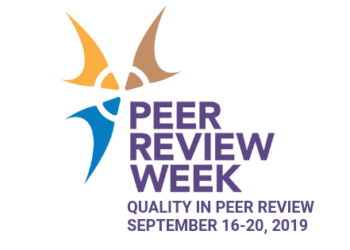Editor’s Note: Today’s post is by Liz Bal. Liz is Director of Open Research Services at Jisc, a non-profit organization focused on providing digital services and solutions for research and education. A biologist by education, Liz has over 10 years of experience in open access publishing and scholarly communication. Prior to joining Jisc, she held various publishing roles at BioMed Central and Springer Nature.
The pandemic presented an urgency for effective science to inform decision-making and has shown just how fast and open scholarly communication can be. Researchers shared their preliminary results on preprint servers and institutional repositories at unprecedented rates, inspiring various preprint peer-review initiatives. Journal publishers processed manuscripts from submission to publication in record time. And much of what we know about Covid-19 has been learned through data sharing and cooperation at the international level, with the use of critical data-sharing infrastructure.
While the research community has responded with an extraordinary level of openness, speed, and collaboration, it has also brought to the fore some of the key challenges we still face in the transition to open research – and the opportunities they represent.

Opening up access to research articles
Many of the major academic publishers took the welcome step of removing their paywalls to research relating to COVID-19, making it freely accessible to all. However, this has also underlined the need to accelerate the transition to full and immediate open access for all research, so that we can be in a better position to respond to other global challenges in the future. As we reflect on the lessons learned from the pandemic, it is more important than ever that we achieve a full transition to open access in a way that is sustainable, cost-effective, and equitable for all – supporting a diverse range of models and reflecting the needs of the research community.
Opening up the data associated with articles
Open access to published articles, while crucial, is not alone sufficient to derive the full benefits of open and rapid dissemination of research. If the data from which the findings are based are not accessible, the conclusions drawn in the research articles cannot be validated. As a key principle of open research, data sharing delivers a number of benefits, including increasing data re-use, enabling replication studies, and facilitating the peer-review process itself.
In a recent analysis of 5,905 articles on COVID-19 published during the pandemic, only 13.6% were found to share their data. In turn, a lack of transparency and data sharing has arguably led to a number of high-profile retractions. This raises the question of how long “Data available upon request” will continue to be accepted in publications, and what measures need to be in place to facilitate the sharing of underlying datasets. Specific initiatives such as SHARE and OpenSAFELY have emerged in response to this challenge, as well as calls for more stringent data sharing policies such as the proposed Universal Funders Policy to mandate and reward the open deposition of all records associated with a publication.
Speeding up peer review and publication
While the process of fast-tracking articles is not novel or uncommon in the scientific publishing system, scholarly journals and their publishers responded to the pandemic with a significant effort to move content through the publication pipeline at extraordinary rates. Aided by researchers quickly peer-reviewing work and editors making rapid assessments, such efforts were shown to be highly effective, for example, in helping to achieve a median time from submission to acceptance of just six days in a sample of COVID-19 related journal articles.
While it seems unlikely that journals can continue to operate at this pace or gain such efficiencies in the publication of all research, it has spurred on various initiatives for rapid review that may bring lasting change. Notably, at the start of the pandemic, some publishers launched a collaborative initiative to create a shared pool of “rapid reviewers” for COVID-19 related research articles.
Outside of the traditional journal publishing model, researchers have embraced preprint servers and open publishing platforms as a means of sharing their research findings as quickly as possible. There has been a huge surge in preprints, potentially paving the way for the greater adoption of preprints in other areas of the life and medical sciences. This growing popularity of preprints has coincided with various efforts from the community to peer review them, such as the Review Commons, the Rapid Reviews: COVID-19 (RR:C19) overlay journal, Outbreak Science Rapid PREreview, and eLife’s Publish then Review model, among many others.
This paints a complex and evolving interplay between journals and preprint servers. Moreover, looking beyond the traditional research article, it begs the question as to whether greater efficiencies and societal benefit could be gained through increased transparency throughout the research life cycle – not just at the point of completion of a study. From innovative publishing models like Octopus to alternative article types such as Registered Reports, we may now see a stronger appetite to embrace new forms of scholarly communication.
Maintaining trust in science communication and publishing
Preprints, by definition, contain research findings that have not yet undergone journal peer review. While the rise in preprints during the pandemic can be seen as a positive step towards open research, some COVID-19 preprints received premature media attention, with the misuse of non-peer-reviewed articles by various news outlets. This has led preprint servers, including bioRxiv and medRxiv, to strengthen their usual screening processes – also, perhaps, underlining the need for more engagement with science journalists.
And, of course, journal peer review is not without its limitations, and does not necessarily guarantee reliable and reproducible results. Indeed, the rapid review response of journals has been met with some concerns about the rigor of the peer review process, with some arguing for open peer review as a solution and others recommending new journal editors’ standards for maintaining the quality of peer review during public health emergencies.
Meeting the needs of the reader
Finally, the increasingly large volume of research disseminated during the pandemic has undoubtedly brought the needs of the reader into sharp focus. It has placed a spotlight on the infrastructure needed for the efficient discovery and utilization of research, from ensuring that literature databases and search engines are maintained and optimized, to investing in curated databases such as the WHO COVID-19 Global Literature on Coronavirus Disease Database. It has also led to calls for more high-quality systematic reviews and better linkage between preprints and reviews with the development of Sciety, a new platform for interacting with preprints and public reviews.
Overall, open access, open data, preprints, rapid peer review, and next generation search technologies have all played a pivotal role in the dissemination of research, but will this experience serve to accelerate open research movement? And how will it shape scholarly communication in the future?
At Jisc, our vision is for the process, management, and outputs of research to be as open as possible, as early as possible, and accessible to everyone. In collaboration with CNI, we are hosting a session on ‘Open and faster scholarly communication in a post-COVID world’ at the Jisc-CNI Leaders Conference, with speakers Dr Jessica Polka (Executive director, ASAPbio), Jennifer Gibson (Head of Open Research Communication, eLife), and Joseph Nicholson (Associate Curator, Medical Library at NYU Grossman School of Medicine). Learn more and register here.
Discussion
2 Thoughts on "Guest Post — Open and Faster Scholarly Communication in a Post-COVID World"
Preprint is still print. Important findings are conveyed via the phone and email to people who are on top of the science.
There is often an assumption that all research is captured in preprints, journal articles, books and the like – content that is packaged and channeled via well-managed repositories and publisher platforms. What I’m discovering is that there is a large amount of valuable research going on outside the world of academe and corporate laboratories. It’s being done by NGOs and it’s published as reports and working papers. Only rarely does this content make its way to mainstream discovery channels and repositories. Take, for example, a review of Covid’s impact on global childcare published by the Gates Foundation, or the impact of Covid on substance abuse treatment published by the Canadian Centre of Substance Abuse. In common with most content from NGOs, this content is ‘open’ in the sense that it is freely accessible and it was published rapidly. Yet it is really hard to find and is at risk of disappearing. We’re addressing some of these problems with Policy Commons (we’ve just added our 2.5 millionth item!) but there’s so much more to do. I do hope you’ll cover the challenges of this ‘grey’ research literature at your event.



